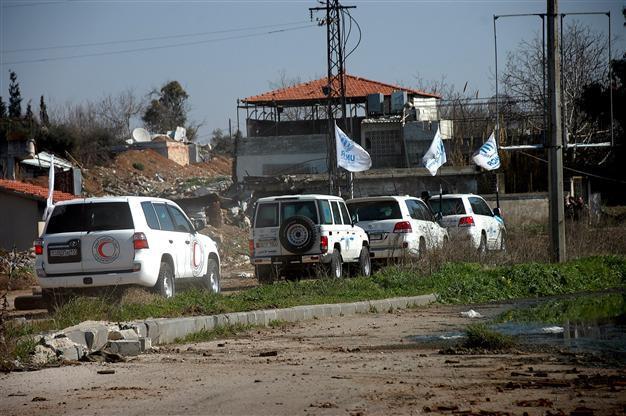UN aid convoy struck in Syria's besieged Homs
BEIRUT - Reuters

UN convoy arrives to oversee evacuation of besieged civilians at the rebels-held old city of Homs, in central Syria, Feb 7. AFP photo
An aid convoy came under fire in a besieged rebel district of Homs on Feb. 8, threatening a United Nations-led operation to bring food and medicine to 2,500 people and evacuate civilians trapped by months of fighting in the Syrian city.The Syrian Arab Red Crescent (SARC) said mortar fire landed close to its convoy and shots were fired at its trucks, wounding one of its drivers.
At least nine Red Crescent and U.N. vehicles were holed up in the city for several hours after dark when the explosions struck, but the team managed to pull out shortly before 10 p.m., leaving two damaged trucks, the Red Crescent said.
"Although the team was shelled and fired upon we managed to deliver 250 food parcels (and) 190 hygiene kits and chronic disease medicines," it said.
Syrian authorities blamed the attacks on rebels but opposition activists accused President Bashar al-Assad's forces of carrying them out, as well as earlier mortar fire which delayed the start of the operation on Saturday morning.
The violence threatens to unravel a humanitarian deal for Homs which was the first concrete result of talks launched two weeks ago in Geneva to try to end the country's civil war.
The conflict has killed 130,000 people, driven millions from their homes and devastated whole districts of Syrian cities - particularly Homs, a centre of protest when the 2011 uprising against 40 years of al-Assad family rule first erupted.
At the Geneva peace talks, which resume on Feb. 10, international mediator Lakhdar Brahimi has been pushing for agreement on aid deliveries and prisoner releases, hoping that progress on those issues could build momentum to address the far more contentious question of political transition.
But even the humanitarian talks have taken time and delivered only modest achievements, the first of which was the evacuation on Feb. 7 of 83 women, children and elderly men from the Old City. Aid workers said many showed signs of malnutrition.
Feb. 9 is due to be the final day of a three-day ceasefire which Russia, a close supporter of al-Assad, said had been agreed to allow the aid to be brought in and civilians moved out.
Video footage of the incident published by activists showed eight white cars with U.N. markings and a truck stopped at a narrow street corner, already strewn with rubble.
A man with a blood on his face was led into a nearby building, before a blast struck on the far side of the truck. It was not clear how much damage was caused by the explosion.
The Syrian Observatory for Human Rights, which monitors violence in Syria, said there were reports that two Syrians had been killed and several wounded by mortar fire in Old Homs.
Opposition fears
Syria's opposition National Coalition said the aid operation in Homs was no substitute for lifting the siege on the rebel-held area, warning that the evacuation of civilians could be "a prelude to the regime destroying the city with the remaining residents trapped inside."
"It is vital to remember that the regime has used similar tactics in the past to change the demographics of some areas in Syria," the Coalition said in a statement. "It has used similar deals to buy time to strengthen its positions on the ground and to kill more civilians."
While the aid convoy was delivering aid in Homs on Feb. 8, fighting continued in northern and eastern Syria.
Twenty people were killed in Aleppo by barrel bombs dropped by Syrian army helicopters, the Britain-based Observatory said.
The improvised explosives, often rolled out of the cargo holds of aircraft, cause widespread and indiscriminate damage.
Hundreds of people have been killed in such attacks in Aleppo city this year and many thousands have fled rebel-held districts, seeking shelter in government-controlled neighbourhoods or trying to cross the Turkish border.
The air offensive has also helped al-Assad's forces take back some ground in Syria's biggest city, which has been contested since the summer of 2012 when rebel forces swept in from Aleppo's rural hinterland to take over around half the city.
On Feb. 8 the Britain-based Observatory reported heavy fighting in the eastern province of Deir al-Zor after the al Qaeda-linked Nusra Front and another Islamist group, Ahrar al-Sham, attacked ISIL, accusing it of seizing control of oil fields and other key installations.
















